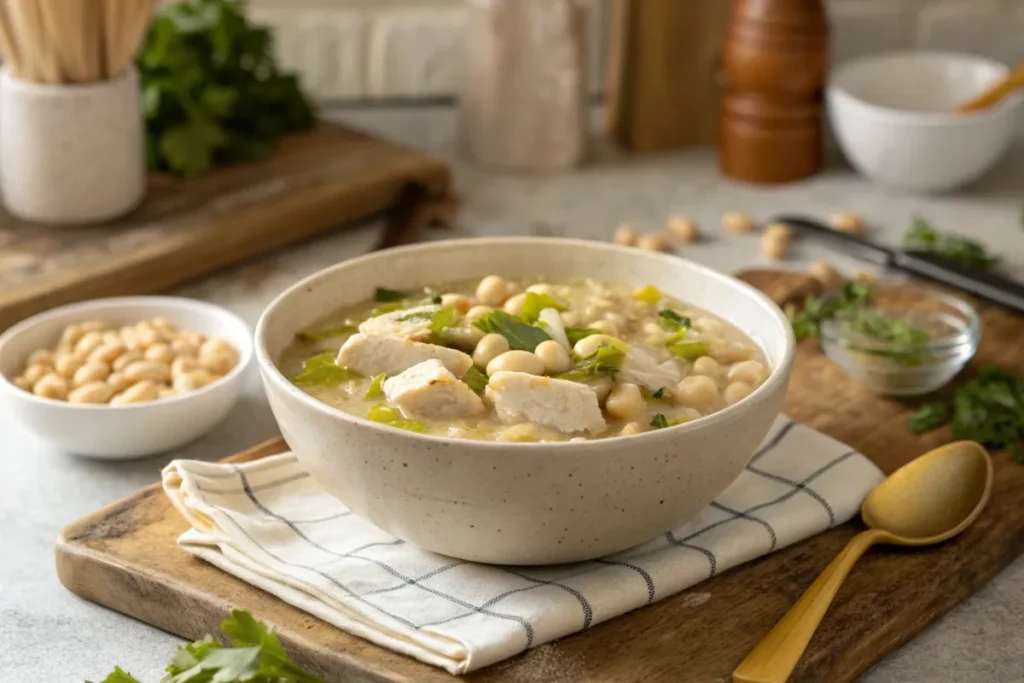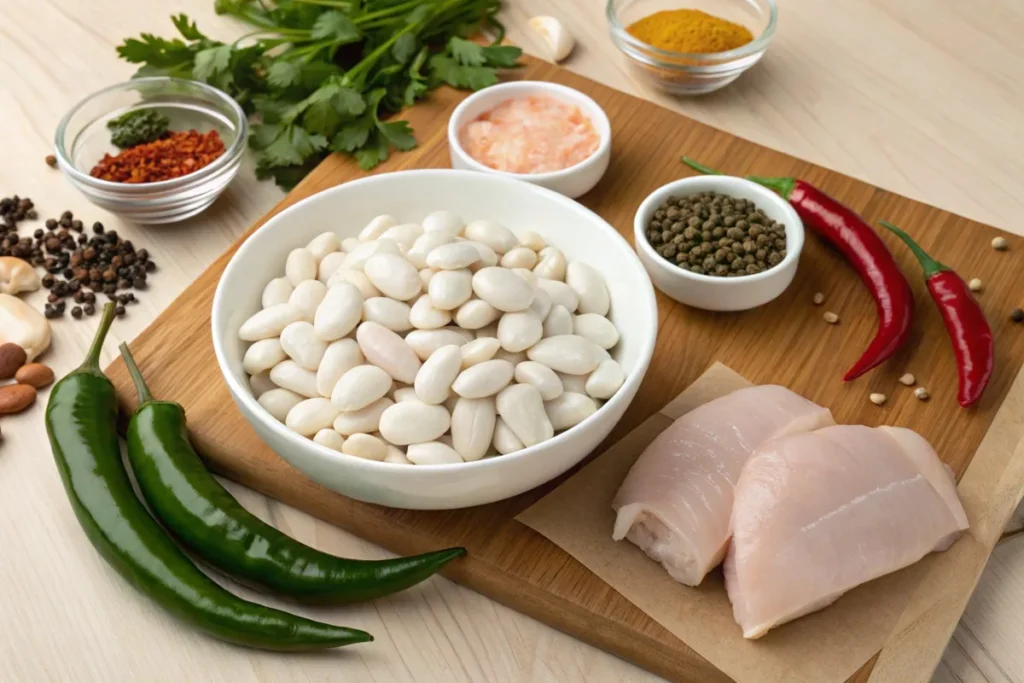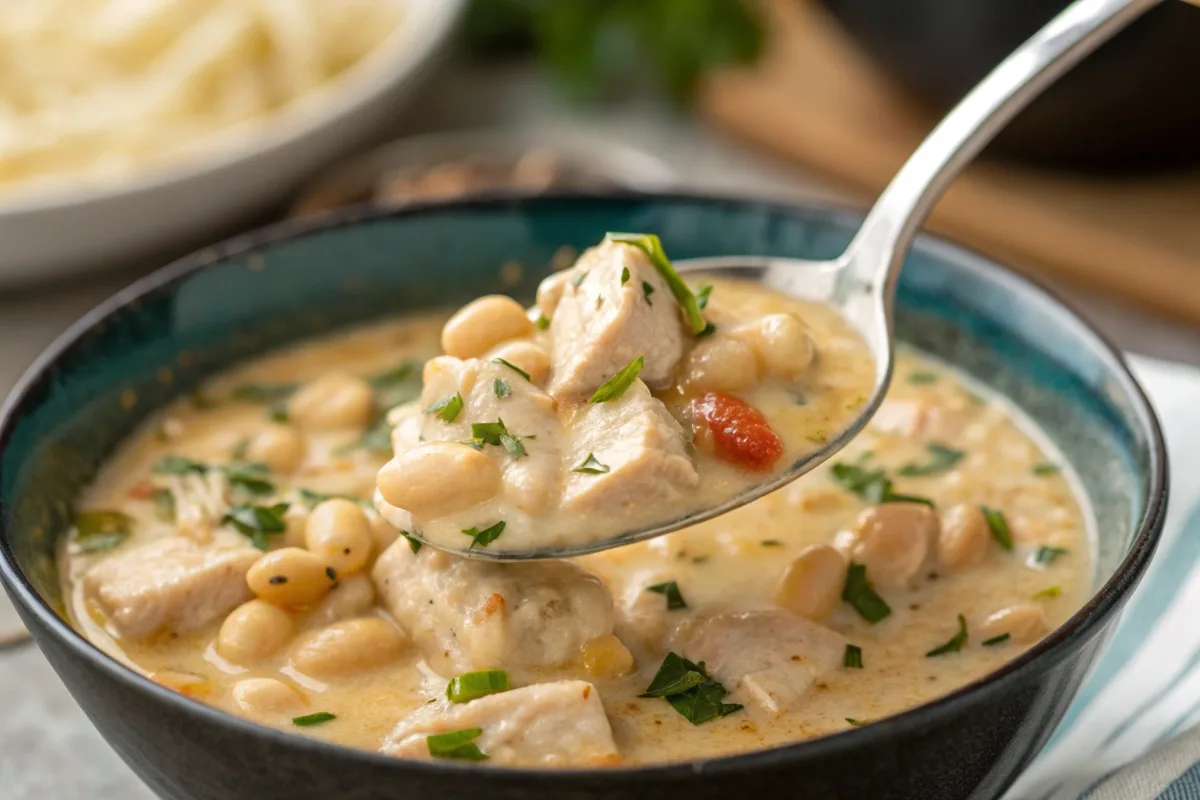Discover what is white chili made of. Uncover its key ingredients, cooking tips, and delicious variations.
Introduction
White chili is a comforting, creamy dish that many home cooks adore, especially when the weather turns cooler. It is often seen as a lighter, milder alternative to traditional red chili. Instead of relying on tomatoes and dark spices, white chili centers around pale beans, lean meat—commonly chicken or turkey—and subtle herbs and spices. As a result, its inviting color and gentle taste appeal to those who want something warm and hearty without the heaviness of classic chili.
In many U.S. homes, white chili has become a staple meal option. However, understanding what goes into this dish and how to fine-tune its flavor can transform an ordinary pot of chili into a memorable culinary experience. Therefore, we will explore the origins, essential ingredients, seasoning strategies, and preparation methods in detail. In addition, we will answer common questions and provide step-by-step instructions for making a creamy white chili at home.
Table of Contents
A Brief History of White Chili
How White Chili Emerged in American Cuisine
Most people are familiar with red chili, a Tex-Mex favorite that includes robust spices and tomatoes. White chili, however, came into the culinary scene later. It gained popularity in the late 20th century when creative cooks experimented with lighter ingredients, such as white beans and lean poultry, to craft a dish that retains chili’s essence but offers a fresher flavor.
Regional Influences and Adaptations
White chili thrives in many regions, from the Southwest—where mild chilies and herbs come into play—to the Midwest, where hearty bean dishes are a way of life. Over time, cooks in various parts of the U.S. have adapted the dish to local tastes, adding different levels of spice, thickness, and garnish. This flexibility has helped white chili gain a dedicated following across the country.
Comparing White Chili to Traditional Variants
Although red chili is often associated with beef and tomatoes, white chili focuses on a clearer broth, white beans, and lean poultry. Therefore, it appeals to those seeking something gentle, earthy, and still comforting. In addition, it can easily be adjusted to fit dietary needs, making it a great dish for gatherings where guests have different preferences.
Core Ingredients of White Chili
Lean Poultry and Plant-Based Proteins
Chicken or Turkey:
White chili typically begins with chicken or turkey. These lean, white meats form the protein base of the dish. Chicken breast or thigh meat is the most popular, providing a delicate, succulent texture. In addition, some cooks choose ground turkey or shredded leftover chicken for convenience. Because chicken is mild, it supports the dish’s other ingredients without overpowering them.
Vegetarian Options:
For those who prefer a meatless version, tofu or plant-based crumbles can step in. These options deliver protein while allowing the chili’s other ingredients to shine. Additionally, a vegetarian variation often includes extra white beans or hearty vegetables like zucchini to make the dish just as filling and nourishing.
White Beans as the Creamy Backbone
Great Northern, Cannellini, or Navy (White Beans):
White beans are at the heart of this dish. They not only provide protein and fiber but also lend a creamy texture that defines white chili’s signature feel. For example, cannellini beans have a rich, buttery quality, while great northern beans offer a smooth, mild bite. Many cooks mash a portion of the beans to thicken the broth naturally.
Light, Flavorful Broth
Chicken or Vegetable Broth:
To keep the dish’s color pale and inviting, cooks often rely on a clear, savory broth instead of tomato-based sauces. Chicken broth works well, but a good-quality vegetable broth fits a vegetarian approach. Therefore, the resulting liquid is gentle and complements the lean meats and beans perfectly.
Aromatics and Seasonings
Onions, Garlic, and Mild Chilies:
To build layers of flavor, start by sautéing onions and garlic. These staples form a savory base that sets the tone for the dish. In addition, mild green chilies—like Anaheim or Hatch peppers—add warmth and depth without overwhelming heat. Jalapeños can also provide a gentle kick if desired.
Spices and Herbs:
White chili often includes cumin, coriander, and dried oregano. These spices enhance the earthy quality of the dish. Cumin’s warm, nutty taste, coriander’s subtle brightness, and oregano’s fragrant aroma blend together seamlessly. Additionally, mild green herbs like cilantro can be sprinkled on top at the end to lighten the flavor.
Creaminess Without Heavy Cream
Dairy or Dairy-Free Thickeners:
To achieve a velvety texture, many recipes stir in a small amount of sour cream or cream cheese near the end of cooking. However, those who wish to avoid dairy can still create creaminess by pureeing some of the beans or adding mashed avocado. For a lighter approach, skip thick dairy products altogether and simply rely on the starch released from the beans.

Flavor Profiles and Seasoning Strategies
Subtle Yet Comforting Notes
White chili is known for its mild, comforting flavor. The absence of tomatoes gives it a cleaner, creamier taste that highlights the natural sweetness of the beans and the savory notes of lean poultry. In addition, the seasonings—cumin, coriander, and oregano—remain gentle.
Adjusting Spice and Acidity
To ensure your white chili is full of flavor, taste as you cook. If the dish seems flat, add a pinch of salt or a squeeze of lime juice to brighten the flavors. If you prefer a bit of heat, chop a jalapeño or include a dash of your favorite hot sauce. Because this dish is so adaptable, it invites creativity and encourages you to adjust seasonings to please your own taste buds.
Garnishes for Contrast
For extra texture and flavor, consider garnishing your bowl. Fresh cilantro, sliced green onions, shredded cheese, diced avocado, or even a dollop of yogurt can bring a pop of color and creaminess. Therefore, the final bowl can be customized to suit each diner’s palate.
Cooking Techniques and Methods
Stove-Top Preparation
The most common way to cook white chili is on the stovetop. First, sauté onions, garlic, and chilies in a bit of oil until softened. Then, stir in spices to release their aromas. Next, add broth, white beans, and poultry. After simmering gently, let the flavors meld and the broth thicken. This method gives you more control over taste and consistency because you can sample and adjust seasonings as the dish cooks.
Slow Cooker Method
Alternatively, prepare white chili in a slow cooker for a hands-off approach. Layer the beans, poultry, spices, and broth, then allow the mixture to cook on low for several hours. In addition, stir in any thickening or creamy elements near the end. This method helps develop flavor over time, making the beans extra tender and the broth even richer.
Pressure Cooker or Instant Pot
For those who need a quicker solution, a pressure cooker helps deliver a flavorful white chili in less time. Sauté aromatics using the cooker’s sauté function, then add beans, broth, poultry, and seasonings. Lock the lid and cook under pressure for a shorter period, resulting in tender beans and juicy meat.
Variations and Tweaks
Southwestern Influences
If you crave a stronger southwestern flair, you could add mild green chilies like Hatch peppers or extra cumin. For a thicker texture, stir in a small amount of masa harina (corn flour). This subtle tweak gives your chili a touch of authenticity while keeping it mild and comforting.
Vegetarian and Vegan Alternatives
Skip the meat entirely, relying on white beans and tofu for protein. In addition, add chopped mushrooms for umami depth. Opt for vegetable broth and omit dairy-based toppings, replacing them with creamy mashed white beans stirred in at the end. The result is just as hearty and flavorful.
Making It Your Own
Do not hesitate to adjust the consistency. If you prefer a thicker chili, mash more beans or let it simmer uncovered to reduce liquid. For a thinner, soup-like consistency, add more broth. Because white chili is so flexible, it invites personalization to suit individual tastes.
Serving Suggestions and Pairings
A warm bowl of white chili pairs well with simple sides. For example, serve it alongside homemade cornbread for a tender, sweet counterpoint. Likewise, a green salad or sliced vegetables can add freshness and crunch. Leftovers freeze well, too. In fact, repurpose them later by spooning white chili over baked potatoes or mixing into a casserole.
For more comforting meal ideas, check out our White Chicken Chili Crockpot Recipe for additional inspiration.
Nutritional Considerations
White chili can be a nourishing meal option, especially when made with lean poultry and plenty of fiber-rich beans. In fact, it provides a good balance of protein, carbohydrates, and some healthy fats, depending on toppings. If you are watching sodium, choose low-sodium broth and taste before adding salt. For dairy-free options, rely on mashed beans to maintain creaminess without added fats.
Nutritional Information (per 100g)
| Nutrient | Amount per 100g |
|---|---|
| Calories | 90 kcal |
| Protein | 7 g |
| Carbohydrates | 12 g |
| Fat | 2 g |
| Fiber | 4 g |
| Sodium | 140 mg |
(Values are approximate and may vary depending on specific ingredients.)
Recipe: Easy White Chili with Chicken
Ingredients

- 1 lb (about 450g) boneless, skinless chicken breasts, cut into small cubes
- 2 cans (about 15 oz each) of white beans (cannellini or great northern), drained and rinsed
- 4 cups (about 950 ml) low-sodium chicken broth
- 1 medium onion, chopped
- 2 cloves garlic, minced
- 1 can (4 oz) mild green chilies, chopped
- 1 tsp ground cumin
- 1 tsp dried oregano
- 1/2 tsp ground coriander
- Salt and pepper to taste
- 1 tbsp oil (such as olive oil)
- Optional: 1/2 cup plain Greek yogurt or mashed white beans for creaminess
Optional Toppings:
Chopped cilantro, sliced green onions, shredded cheese, diced avocado
Step-by-Step Cooking Instructions
Sauté the Aromatics:
- Heat the oil in a large pot over medium heat. Add the chopped onion and sauté for about 3 minutes until it turns translucent. Next, add the garlic and cook for an additional 1 minute. Because you are building the dish’s flavor base, take care not to burn the garlic.
Add Chilies and Spices:
- Stir in the mild green chilies, cumin, dried oregano, and ground coriander. Continue stirring for about 30 seconds to release the spices’ aroma. This step helps deepen the chili’s flavor without increasing the heat level too much.
Add Chicken and Beans:
- Add the chicken pieces to the pot, stirring so they are coated with the spices and aromatics. Then, add the drained and rinsed white beans. Because the beans are mild and creamy, they will help form the dish’s comforting texture.
Pour in Broth and Simmer:
- Pour in the chicken broth. Increase the heat to bring the mixture to a gentle simmer. Reduce the heat to low and let it simmer uncovered for about 20-25 minutes, or until the chicken is fully cooked and the flavors have melded together. Because simmering allows seasonings to develop, taste occasionally and adjust salt and pepper as needed.
Adjust Thickness and Creaminess:
- For extra creaminess, stir in the plain Greek yogurt or mash a small portion of the white beans and add them back to the pot. This creates a velvety broth without adding heavy cream. If the chili is too thick, add a bit more broth. If it is too thin, simmer longer to reduce the liquid.
Finish and Serve:
- Once the chili reaches your desired consistency and taste, ladle it into bowls. Top with fresh cilantro, sliced green onions, shredded cheese, or diced avocado. Because garnishes provide contrast, they can greatly enhance each spoonful
FAQ (People Also Ask)
What is white chili sauce made of?
White chili sauce often includes a base of mild chilies, sautéed onions, garlic, and broth, thickened with a portion of mashed white beans or a dairy element like Greek yogurt. Therefore, the sauce remains creamy and light in color, making it ideal for white chili.
What is the difference between chili and white chili?
The main difference is that traditional chili typically includes tomatoes, beef, and darker spices, while white chili relies on white beans, lean poultry, and clear broth. In addition, white chili omits tomatoes for a creamier, milder taste.
What’s the difference between red and white chili?
Red chili usually features red beans, tomatoes, and red chili powder, resulting in a darker color and bolder flavor. White chili, on the other hand, is made with white beans, mild spices, and lean poultry, delivering a lighter color and gentler taste profile.
What is another name for white chili beans?
White chili beans are often simply called white beans or cannellini beans. Some recipes may use great northern beans or navy beans instead, referring to them by name. In essence, they are all mild-flavored beans that suit white chili perfectly.
Conclusion
White chili is a versatile dish that answers the question, “What is white chili made of?” with a comforting combination of lean poultry, mild white beans, gentle spices, and creamy textures. Because it is easy to adjust, you can tailor the flavor, thickness, and toppings to your liking. White chili’s warm, mellow taste makes it a go-to comfort food in many American kitchens. Therefore, experiment with ingredients and methods until you discover your personal favorite version. By understanding what goes into white chili, you can create a dish that not only satisfies hunger but also delights your taste buds.

